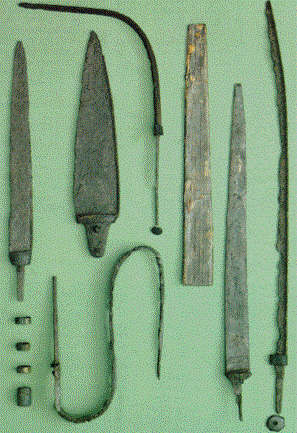The Swords
Eight nearly whole swords and fragments of three sword-blades were found. Common to all the swords is that they were made of iron, single-edged and the tang lies on the middle axis of the sword. The swords are definitely not of Celtic form as the Celts only used double-edged swords, but of Germanic form.
Picture, courtesy of (1), fig. 16, p. 24.
click it to get a larger one (29 kb)The swords can be split up into three groups.
- Swords with concave sides, broad back and tang without rivet-holes.
This group includes three of the whole swords and the three fragments of sword-blades.
The length of the blades varies from 35 to 57 cm (14 to 22.5 inches); the total length varies from 48.5 to 70 cm (19 to 27.5 inches).
The handles are all mounted by applying a bronze knob at the end of the tang.
Two of the swords have been deliberately bent before the sacrifice.
- Swords with flat sides, somewhat extended back and tang with rivet-holes.
This group includes two of the swords.
One sword has a 28 cm (11 inches) long, very broad blade, which is 7 cm (2.75 inches) at the base. It can best be characterized as a stroke-knife. The handle has been mounted with two rivets.
The other sword is a little longer (31.5 cm – 12.5 inches) and slimmer (3.5 cm – 1.5 inches at the base). The handle was mounted with rivets, fitted with 3 bronze-bands around the handle and a bronze-cap at the end of the handle.
- Swords with flat sides, non-extended back and tang without rivet-holes.
A group of slim swords with the length of the blades varying from 36 to 45 cm (14 to 18 inches).
Together with the swords two nearly complete scabbards and fragments of two more were found. One of the swords of the third group was found within its scabbard.
The scabbards are made up of two hollow ash-wood plates, probably fitted together with bronze bands and leather strings.
A 20-24 m2 (215-260 square feet) area in the bog was covered with a layer of iron-rust. Study of the rust-layer showed traces of small iron-rings used for chain mail. The diameter of the rings varies from 0.4 to 1.0 cm (0.15 to 0.4 inches), but most of the rings have a diameter of 0.6 to 0.8 cm (0.25 to 0.3 inches).
The size of the area covered with rust indicates that 10 to 20 chain mails have been sacrificed.
This is the oldest traces of chain mail in all of Europe and probably imported from the Celtic areas in Central Europe.
